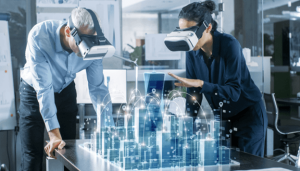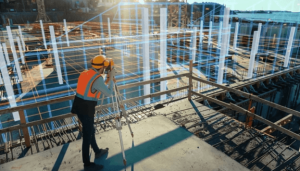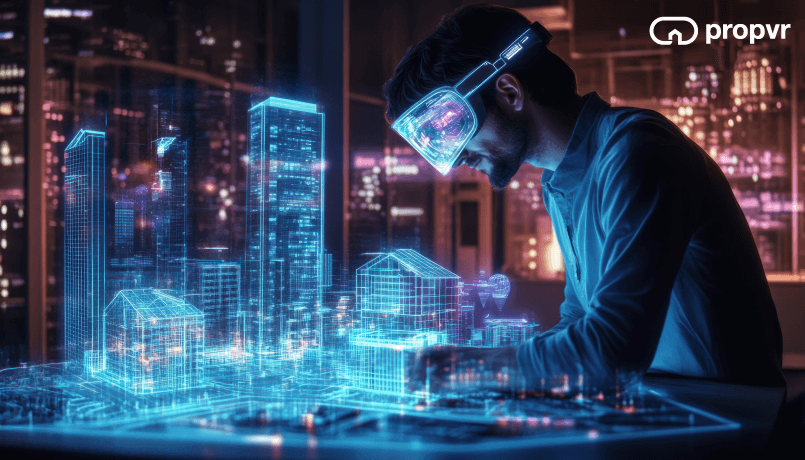Your dream project deserves nothing less than perfection, and Augmented Reality (AR) is making it possible like you imagined. Take a walk through your future home, visualise the walls, and redefine the layouts before a single brick is laid, all through a pair of smart glasses. AR is enhancing and revolutionising construction. This technology minimises costly rework by overlaying digital models onto real-world environments. Overall, this will help improve precision and foster seamless collaboration between teams. AR technology transforms architectural visions into reality with unmatched efficiency and accuracy from concept to completion.
Here are seven distinct ways that AR can be used in the various stages of the construction process that will redefine the way you see homes:
How To Use AR Efficiently and Effectively in Construction?
AR technology transforms construction by maximising efficiency, accelerating development, and minimising rework while ensuring a safer work environment. Here are some key applications of AR devices in the industry:
Visualise and Design With AR
By overlaying 3D models onto real-world environments, AR provides real-time, immersive visualisation of a project’s design, allowing for better scale, placement, quality control and structural alignment assessment. This approach completely outdates the traditional blueprint approach while building development and enables teams to identify potential design flaws early in the process, reducing costly revisions and construction delays. While scaling can be a little bit tricky, AR in construction will eventually enable the developers and customers to see the project from every angle and zoom into any specific element at all times.
This eliminates the need for multiple construction site visits and helps convince investors that their money is being invested in a risk-free project via design visualisation. Several companies have fully integrated AR tools into their decision-making processes, enabling them to develop even the most intricate architectural designs while enhancing workflow and project planning.
AR devices allow you to showcase your project more effectively by visualising the connection between separate construction elements, ensuring optimal integration and delivering stronger, more cohesive results. Architects can use the same tools to overview the project and install any design features that might be necessary but went unnoticed initially.
Advanced Project Planning Techniques

Developers can easily reduce errors and optimise the project for remote assistance by integrating Building Information Modeling (BIM). This will be helpful for AR, architects, engineers, and project managers, enabling them to visualise and interact even before construction begins. You can create digital twins for intelligent project planning, making monitoring structural integrity easier, optimising energy consumption, and strategically doing renovations or expansions. After merging it with AI, multiple developers have predicted the future real estate values of the property. This is done by analysing historical construction data, environmental factors, and project-specific constraints.
AR can help make decisions much faster, collaborate smoothly, and approve projects without any delays. With AR, project teams can overlay 3D models onto real-world spaces, giving them a clear, real-time view of how a structure will fit into its surroundings. These advanced planning techniques enable efficient material utilisation, promoting more sustainable and eco-friendly construction practices.
Advancing Safety Training
Augmented Reality (AR) provides real-time situational training to workers, helping them recognise and respond to dangers before they become real threats. These safety trainings make the workplace safer from high-risk accidents and frequent workplace injuries.
Here’s how AR is helping to redefine safety training:
- Real-time hazard visualisation: Workers can experience simulated disaster scenarios of high-stress situations, training them to react quickly
- Spotting risks: AR acts like a virtual safety guide, spotting potential hazards such as fall risks, exposed wires, or unstable structures before they become real threats. It allows workers to experience and understand these dangers in a risk-free environment.
- Hands-on equipment training: Workers can practice operating heavy machinery in a risk-free virtual setting before using real equipment.
- Emergency response drills: AR allows teams to rehearse fall prevention techniques, fire evacuation protocols, and equipment failure responses while the project planning is just starting
Thus, AR helps boost confidence, improves preparedness, and significantly reduces workplace accidents. These virtual high-risk situations will help them understand how to act in real-life tragedies if they ever occur in the workplace. As construction companies continue to adopt AR-powered training, the industry is moving towards a safer, smarter, and more secure work environment for everyone.
Digital Assistance and Cooperative Work
AR-based digital assistants make work easier by providing real-time, hands-free guidance. Workers can easily glide through step-by-step assembly details and maintenance instructions virtually. This helps construction teams work faster and more accurately, reducing mistakes and the need for rework. Managers, architects, and engineers can also make changes on the spot and collaborate remotely after seeing the much more interactive project version.
Hence, AR helps eliminate delays by improving communication and making quicker decisions. With AR-enabled smart glasses and headsets, supervisors and workers can conduct inspections remotely, ensuring safety compliance. By integrating AR technology into daily operations, construction companies can build smarter, work faster, and create a more connected, intelligent, and automated construction ecosystem.
Real-world measurement with Digital Data Mapping

AR mapping systems can enhance your property’s construction speed and efficiency. You can blend digital and physical aspects of construction effortlessly by overlaying real-time measurements with digital information, giving you a clearer and more accurate view of the project as it takes shape. This is done by leveraging GPS, satellite imagery, and 3D models, fusing them with real-time sensor data to provide a more immersive and intuitive navigation experience.
Here are some components of AR technology that can help in digitally mapping out the construction process:
- Real-Time Site Visualization: AR overlays digital 3D models onto the physical construction site, allowing stakeholders to visualise the final structure in its actual environment using spatial planning.
- Enhanced Navigation & Safety Guidance: Integrating AR with GPS and real-time sensor data helps workers navigate complex construction sites with precise turn-by-turn guidance, even taking help of LiDAR and other sensors.
- Material Database: AR mapping systems can sync with inventory databases to display the location of construction materials and equipment in real-time, even automatically displaying any potential traffic delay for storing and managing new materials.
- Quality Control: Automated quality control through AR-assisted inspections enhances precision and reduces errors. These tools ensure that all digital information is regularly updated and displayed in the best possible way.
Digital construction planning uses smart technology to create highly accurate, interactive models of real-world spaces. You can precisely map out the projects using tools like computer vision, depth sensing, GPS, and motion tracking. AR, integrated with computer vision, helps understand and recognise objects, surfaces, and boundaries. At the same time, GPS keeps track of location in real time, while motion sensors ensure everything stays aligned. Depth sensors, such as LiDAR, further enhance realism by measuring distances and positioning digital objects correctly in 3D space.
GPS provides real-time location data, and the IMUs track device orientation and movement. Multiple organisations have started digitally mapping their construction sites, which helps create a vast database of all materials and the overall construction processes.
Precision Monitoring and Compliance Checks
Augmented Reality (AR) is revolutionising construction site monitoring and documentation. These tools help integrate digital information directly into the physical environment, enabling progress tracking and documentation. This is done by providing a comprehensive visual record that project stakeholders can access remotely. Furthermore, AR devices facilitate non-destructive testing (NDT) methodologies by visualising subsurface elements such as rebar configurations, embedded conduits, and utility lines.
This capability enables predictive maintenance support and reduces the risk of structural failures with particular data overlays. You can simplify the verification process with real-time documentation and remote collaboration. AI-powered systems continuously monitor materials, which will quickly identify any discrepancy or deviation from quality standards. This proactive approach prevents costly rework and delays, ultimately elevating project quality and client satisfaction.
Operational Assistance
AR makes construction smarter and more efficient by bringing digital blueprints to life in real-world settings. For workers on-site, AR acts like a real-time guide, providing instant access to critical details about structural components, installation steps, and material placements. With this level of accuracy, mistakes are minimised, and rework is significantly reduced. AR makes remote collaboration seamless—experts off-site can visually guide teams through complex tasks using live video annotations, helping solve problems faster and keeping projects on track.
Beyond construction, AR technology also plays a crucial role in maintenance. Technicians can see any digital overlay of hidden systems like wiring, plumbing, and ventilation, making it easier to identify problems and make repairs. This helps speed up the process and extend the life of the building’s infrastructure. Hence, AR makes construction much simpler and smarter.
Step Inside Your Designs: The New Era of Smart Construction
Augmented Reality (AR) is transforming the construction industry by making every step more precise, efficient, and safe. Architects and engineers can now step inside their designs, adjusting 3D models in real time as they overlay them onto real-world spaces. Workers can train in a virtual environment, practice handling hazards, and receive real-time safety alerts before operating heavy machinery.
AR can make the project move forward more smoothly without any mistakes. AR also allows project managers to monitor progress remotely, making quick, informed decisions without always needing to be on-site. This technology is setting a new benchmark for construction, offering the accuracy and control that developers have always needed.
Frequently Asked Questions
Answer—AR is a tool that integrates digital models with real-world construction sites, enabling architects, engineers, and workers to visualise and interact with designs in real time. Some AR tools make planning, execution, and project monitoring easier and more precise, helping teams work more efficiently and avoid mistakes.
Answer- AR provides hazard simulations which help workers recognise risks and practice safety protocols before engaging in high-risk tasks.
Answer—Yes, AR creates interactive 3D models when integrated with building information modelling (BIM). These tools enable spatial planning of the project, minimising any design conflicts and optimising resource use.
Answer- AR makes remote collaboration seamless by allowing off-site experts to guide on-site workers in real time. With live video annotations, teams can communicate more clearly, make faster decisions, and stay better coordinated throughout the project.
Answer—AR helps bring blueprints to life by overlaying them onto actual structures, making real-time inspections easier. It can spot deviations, ensure everything meets construction standards, and catch mistakes early, reducing costly mistakes.
Answer- AR can be accessed through smart glasses, tablets, mobile devices, and AR headsets. Companies can also use VR sets actually to step into their “virtually constructed” building.
Answer- Yes, AR allows technicians to see hidden systems like wiring, plumbing, and HVAC components, making it easier to diagnose issues, perform maintenance, and carry out repairs without unnecessary drilling or disruption. Question 1- What is Augmented Reality (AR) in construction?
Question 2- How does AR improve safety in construction?
Question 3- Can AR help in project planning?
Question 4- Is AR useful for collaboration between construction teams?
Question 5- How does AR help with quality control?
Question 6- What devices are needed for AR in construction?
Question 7- Can AR be used for the maintenance of completed buildings?

